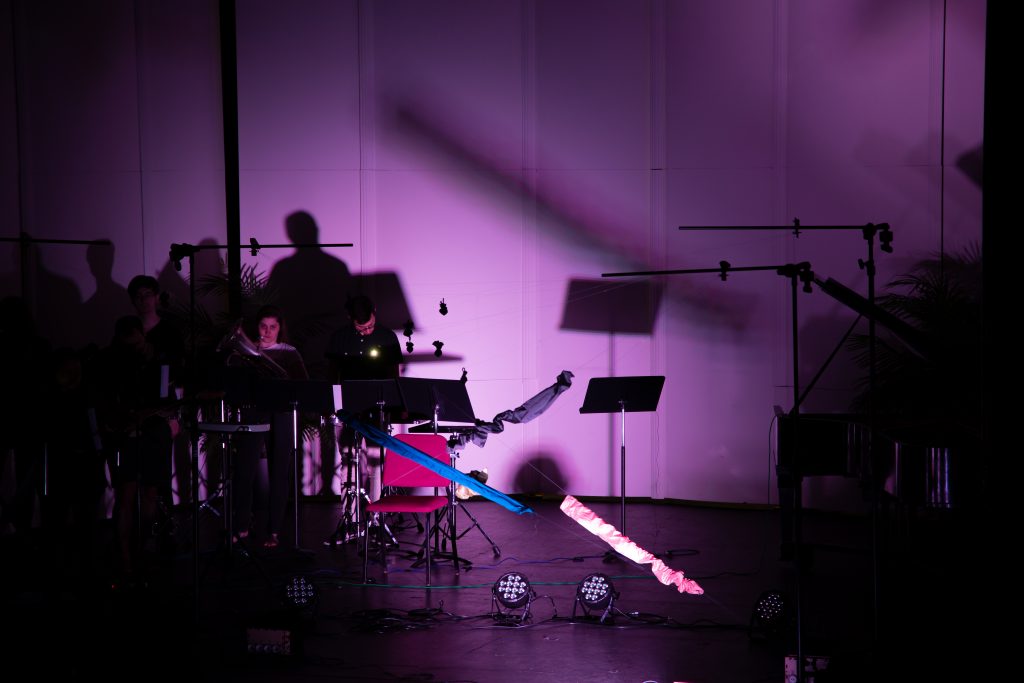Our piece is a collection of four long strips of fabric that were animated through shirring and diagonal movement. The pieces appeared to be weaving between each other in mid-air.

Each piece was chosen from an array of the same color scheme and moved as its own individual body, but the pieces were clearly connected in both ability and appearance. The piece was accompanied by a musical arrangement from Exploded Ensemble, and the performance was guided by the tempo and mood of that arrangement. It started with slow, methodical movements of the fabrics, and as the tempo rose, the movements became rhythmic and quick. The piece used simple lighting changes to allow for different spotlights on fabrics and the transitional stages to shift focus, as well as the starting scene with lights fading in and the ending scene with lights fading out. For most of the parts, only one or two pieces of fabric are moving at the same time. At some points, only one piece of fabric was visible.
Process
Our initial idea for the project was to have a pole-climbing contest between several fabrics, each piece of fabric representing one instrument or one section of music in the accompanying piece. It progressed to having diagonal or multidirectional poles instead of only vertical ones. After a simulation with the diagonal crossing pole idea, we realized that the fabric will appear to be weaving into each other, which is a more complicated and interesting action than climbing, so we shifted our focus from climbing to weaving. However, actually weaving the fabric would create many other problems. The lines crossed would get tangled once there’s more than two pieces of fabric, and if the fabric was caught by another fabric, the fabric would be stuck with the other one, which is totally opposite of what we want. To solve this problem, we had to add distance between the base of the lines, so the lines are not actually weaving into each other, but from the audiences’ perspectives it would appear that they were.
Reflections
(Martha) I found that finding a way to create expressive movement was the most difficult part of this project for me. Trying to find a way of actualizing the movements that I had imagined for the pieces was challenging for me because of the limited experience I had in the area of rigging this type of piece. At the beginning of the project, I became frustrated very quickly while experimenting with rigging setups because I didn’t understand the sources of various issues we’d run into. But after establishing a rigging setup and having some practice with the setting it up, I found it easier to make progress in other areas of the project, such as appearance of fabric, or the choreography of the individual pieces together.
I think ultimately our project was very successful in acting as its own piece while having enough interactivity to work with the musicians in an interesting way. I really liked having the music to provide a tempo and atmosphere and guide the performance, and I think one of the most successful parts of the performance aspect of the piece was that the movement wasn’t the same throughout the piece at all. In the beginning, as the tempo of the music was slow, the pieces also moved slowly and methodically. Then, in one of the most fast paced parts of the song, I turned up the speed and turned down the damping, which created a totally different effect from the movement in the beginning of the performance.
In terms of changes I’d make in the future, I would’ve liked to have had more practice performing with the musicians so that the choreography of the pieces would’ve been more intentional. I think generally we ran out of time to perfect the choreography in the piece, so just practicing moving the four pieces together would’ve made the piece stronger.
(Stephanie) In the initial stages of this project, we were always working with only two pieces of fabrics. Even though it was trying to get the setup right in the first place, it created challenges as we progressed because of the limited practice and time devoted to set up more than two pieces. Ultimately, our performance was successful after giving up and changing some of the riggings we previously had. I also improved in terms of performing the project. Before the first rehearsals, I haven’t had too much experience with this kind of performance, so I would get easily nervous and frustrated when we encounter obstacles we did not expect, like counter-weights falling off, lines breaking, motor malfunctioning, etc. Through more practices and rehearsals, I learned how to perform even if something is not working as intended, and adjust/modify according to all kinds of unexpected activities.
We haven’t had all riggings solved until the last rehearsal we had, which in my opinion, was too risky, but the results we got from that rehearsal was quite pleasing. We were able to tune the lights and the actions of the fabrics with the music. The lights and shadows created scenes that were unexpected because it was the first time we incorporated lights pointing to all directions instead of focused in the center.
In the future, if I have a similar project, I wish I can collaborate with the musicians more. The lack of collaboration almost made the final performance improvisational. If we had more practice with the musicians, I feel like it would be a stronger performance with a more obvious connection among the fabric, the light and the music.
Leave a Reply
You must be logged in to post a comment.